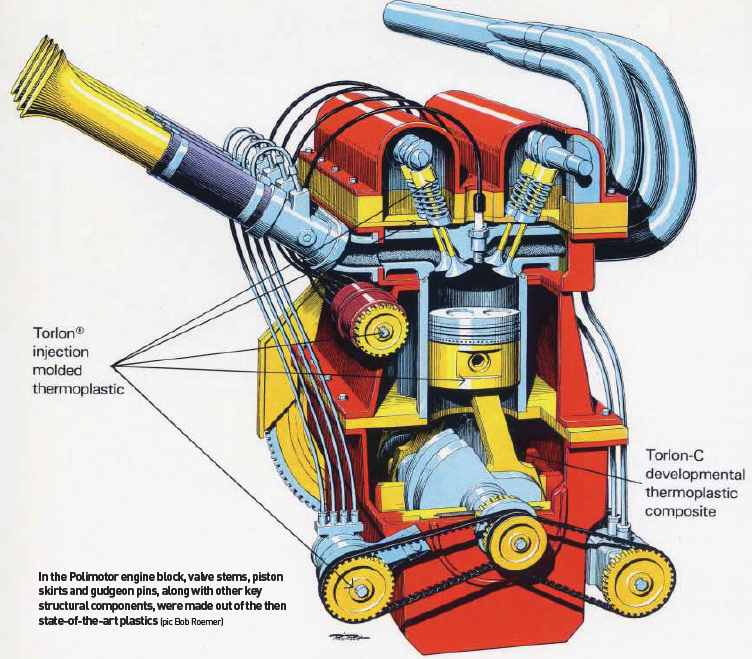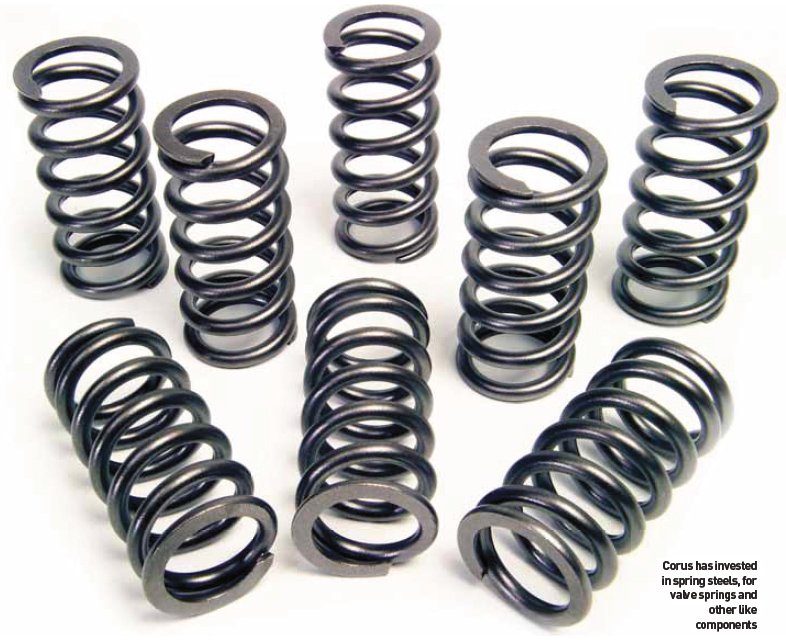Developments in alternative materials are driving change in the drivetrain and bringing benefits to an industry trying to reduce emissions and improve performance
Talk to anyone involved in the automotive supply chain and chances are you’ll hear about new materials being incorporated in their products as a result of relentless competitive and legislative pressures on the industry. Within the last decade, environmental concerns have certainly moved centre stage and the auto industry has responded by seeking to tap into that virtuous circle where weight reduction improves fuel economy, enhances performance and still brings the prospect of reduced emissions.
Yet the forces shaping the choice of materials are much more complex. Simple substitution of materials is rarely the most appropriate route to enhanced value. Each material brings with it a specific profile of characteristics and requirements that determine how it can be shaped, joined, formed and ultimately used. Developments in any one of these parts of the chain will dramatically affect the adoption of a material and its relative competitiveness.
Lightweight end of life
With the introduction of ‘end-of-life’ policies and more sophisticated lifecycle analysis being applied to specific material choices, the picture has become even more complex. As Corus’s Jon King has pointed out, in taking the longer view, some of the advantages of new lightweight materials may be less obvious and dominant than they originally appear. Factor in the energy used in production, as well as the costs and difficulties of recycling some of the more sophisticated composite materials, and the balance can tip back in favour of traditional materials with wellestablished reuse and recycling provisions.
Material choice is a complex and ever-shifting process, where tradition plays its part, but the balance of other factors means that end users can no longer be sure that particular components are made of a particular material. Engine blocks are a case in point. Alloy and iron blocks have been almost randomly adopted by manufacturers over recent decades, with an individual company’s engineering traditions seeming to have as much to do with the choice as anything else. As casting processes and machining techniques have evolved though, so the relative costs and advantages of employing the different materials have ebbed and flowed.
Reinventing traditional materials
King makes a persuasive case for material suppliers to the automotive industry. “The issue for us is not to simply laud the claims of steel over other materials, but to find the most appropriate materials for any engineering application. Part of this involves developing the material itself, its chemistry and structure, but also addressing the processing, machining and working issues to ensure it best meets the needs of each new application. Yet another part of the task is to provide the data and tools necessary to bring our materials before designers and engineers in a form where they can best appreciate their potential.”
As a direct consequence of this, the past few years have seen Corus devote significant resources to developing software tools and programmes to help designers assess the potential of the latest generation of steels for their particular design application. Indeed, modelling software has become as important as metallurgy and chemistry in determining the ability of new materials to successfully penetrate the market.
In the US, Ford is already using Virtual Aluminium Casting (VAC) software to test new engine components in a risk-free environment. Virtual testing of alternative materials offers quick and accurate results. Yet increasingly, the task presented to those promoting alternative materials goes beyond creating the right material; they must also ensure that the necessary design tools are available to facilitate its evaluation.
Time for magnesium
The appearance of suitable testing tools could serve to raise the profile of magnesium as a component material. With magnesium costs continuing to fall in comparison with those of aluminium, and with the development of more sophisticated, low-waste casting techniques, maybe magnesium’s time has come. High-pressure die casting, using creep-resistant magnesium alloys such as AM-HP2 and AM-SC, developed by the Australian Cast Cooperative Research Centre and AMT, look set to increase the exposure of magnesium as an alternative material in developing powertrain applications.
It could be that these newly-developed casting processes hold the key to reducing the associated costs and increasing magnesium use. As such, the continuing development of the T-Mag high-integrity, permanent mould, magnesium casting process will be closely monitored, appearing as it does to offer a significantly higher yield than existing diecast techniques, as well as being capable of dealing with a wider range of complex shapes.
Advances in steel
Though steel remains the dominant material in vehicle powertrain production, steel producers have not been resting on their laurels. Indeed, the drive to produce higher-quality material by exerting greater control over the composition and purity of their product has been the focus of much recent investment by Corus and ArcelorMittal. Clive Sutton, Marketing Manager for Corus, points towards the fruits of a major investment made by the company that is now coming on stream: “High-strength, aircooled steels can meet modern performance requirements without the need for subsequent heat treatment, whilst controlled microstructures minimise distortion and promise enhanced fracture splitting characteristics.” Corus’s investment in spring steels, for valve springs and other like components, similarly allows the company to offer vehicle manufacturers higher-performance materials at a lower cost. For high-volume applications, as a result of recent work, forged steel conrods can again be offered as an alternative to sintered rod. Corus’s research has refined the fracture-split process, separating rod and bearing cap, with the focus now on the potential of laser splitting.
Plastic potential
It is nearly a quarter of a century since the Amoco-sponsored Polimotor race engine demonstrated the potential of plastics. In the Polimotor engine block, valve stems, piston skirts and gudgeon pins, along with other key structural components, were made out of the then state-ofthe- art plastics. Even conrods, oil scraper rings and tappets were constructed from various types of thermoplastic polymers to promote the sponsor’s Torlon thermoplastic resins. Twenty-five years on, there can be no doubt that plastics could be employed as a material for a significant number of internal engine components. But when the numbers are crunched and the constraints of volume production assessed, plastic doesn’t yet add up to a viable alternative for internal engine components.
Plastic has made great inroads in engine induction systems. The inherent flexibility of the material allows for the integration of a range of fuel system components. Incorporating numerous discrete components, the resulting manifolds are different in character to traditional induction systems. Of course, this can bring with it benefits in reliability, noise suppression and ease of assembly, but at the same time these manifolds require material suppliers and moulders to work in close cooperation at an early stage of the design process. Delphi, for example, has adopted what it terms a ‘systems approach’ to the development of integrated air/fuel modules, introducing mixture motion control devices within manifold modules made in either aluminium or vibration-welded composite materials. Increasingly, it is composite construction that is being adopted where high volumes are anticipated.
An even more obvious use of plastics are in non-stressed rocker covers, pump housings, sump pans and similar applications. These have been widespread for some years, but the latest generation of polymides offer significant advantages, with thin-wall designs and high impact resistance. For example, DSM offers Akulon, as well as a range of other engineering thermoplastics, increasingly adopted for automotive applications and DuPont’s ZytelHTN PPA features in the recent SPE Automotive Division award-winning powertrain components. Other future developments that may influence powertrain applications include DuPont’s nanometal/polymer hybrids, where the addition of a thin layer of metal deposited via a wet electrode position process on a plastic core has been shown to dramatically increase the strength and robustness of engineered plastics. This allows them to be adopted in structurally-significant applications. Currently, US-based Morph Technologies is exploring these materials with a view to taking advantage of their advanced properties and enhanced performance for the automotive sector.
Aerospace and automotive convergence
Increasingly, automotive technology and materials requirements are converging with those of the aviation and aerospace sectors. One company involved in the sharing of technology is Advanced Composites Group, which offers aerospace-proven expertise to the car industry. But it is not just in composites that these overlaps are occurring. Steel suppliers say the increasing performance demands of the automotive sector now mean the specifications outlined for each sector are drawing ever closer.
GKN has been a pioneer in the use of composites in drivetrain components. The company’s work is now being further developed by Spinning Composites, the company currently working with manufacturers to develop engineering solutions where the need for high-performance components has to meet rigid space constraints. Two decades ago, Renault introduced the plastic driveshaft in the Espace Quadra and, more recently, a later version of the same component has appeared in various front-wheel drive applications. With the ability to increase the critical speed (bending resonant frequency), composite driveshafts offer durability beyond those made from conventional materials and are only bettered by their lighter, more compact carbon-fibre counterparts.
Interest in the use of sintered materials has continued to grow, with organisations such as the European Powder Metallurgy Association promoting the potential of advanced sintering techniques in developing materials for specific applications. While sintered materials have held a traditionally important place in powertrain assembly, being very widely used in conrod production and a range of other internal engine and transmission components, the potential for further use involving complex graded structures and combinations of powdered materials to generate desired performance characteristics remains.
Hybrid vehicles
The significant growth of the hybrid vehicle market presents its own particular challenges to materials technologists. ArcelorMittal has been working on adapting steels used in large power generation formats for use in this particular area. Key to the development of hybrid propulsion technologies is improved generator efficiency, as explained by Sigrid Jacobs, Product Development Manager for Electrical Steels with ArcelorMittal: “It is a continual balancing act to develop steel grades that combine the necessary electrical properties while minimising efficiency losses and heat build up, whilst retaining the necessary mechanical characteristics to cope with the ever-increasing rotational speeds that are also required to produce the required outputs.”
With regards to this, Jacob points to their new M210-35a grade steel, developed in collaboration with their automotive partners to meet some of these challenges. Elsewhere, ArcelorMittal Auto Research Centres are working to adapt co-laminated steels, originally used for vehicle structures, for use in powertrain applications. Yet the company remains acutely conscious of the need to develop sophisticated models of metallurgical processes to provide the necessary theoretical base for material choice and design specification.
End-user benefit
Powertrain vibrations and driveline coarseness are no longer acceptable, even in the cheapest, high-volume passenger vehicles, while the standards expected in commercial vehicles have also increased dramatically in the last decade. Innovative material use has made a considerable impact in regards to NVH improvements. ArcelorMittal, for example, has introduced a range of ‘quiet steels’ for use primarily in body-in-white applications but these are also increasingly adapted for various elements of powertrain construction. In the US, the Materials Sciences Corporation is committed to the development of a variety of viscoelastic core materials, which can be tailored to meet specific NVH issues arising from each vehicle application.
With environmental and associated vehicle emissions concerns taking centre stage, it is all too easy to overlook how advances in materials technologies have brought significant benefit to car design and construction. Yet it is these largely-ignored materials that can have immediate effects on improving real-world performance and economy, while helping to reduce the very same vehicle emissions.


































